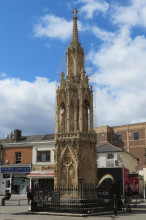 Waltham Cross.
Waltham Cross.
Waltham Cross, North-East of central London just within Hertfordshire, by the border with Essex, is a 13th Century cross put up as one of a series by Edward I in memory of his wife, Queen Eleanor. It is the largest of the three such Eleanor Crosses which survive, and is easily accessible from central London. (A separate page gives more detail on the story of the Eleanor Crosses.)
Today, Waltham Cross stands in a square, rather lacking in character, with a side of a modern building and shopping street to one side, and a road with Victorian and Edwardian buildings the other. But it has the advantage that the Cross can be walked all round and appreciated properly: at one time it had stood in a narrow road with houses up against it, so could not be seen from all sides, and was additionally vulnerable to damage by coaches bumping against it.
In pale stone, the Gothic monument, within an iron fence, stands on low steps and rises in four stages of diminishing size to a total height which cannot be far short of 50ft. It has been restored considerably, particularly the middle two stages, and the sculptures first restored, and then the figures replaced. The most significant restorations were in 1832-3, 1885-92, and 1950-53 according to Pevsner, and a look at the stonework shows much to be recarved and replaced. Nevertheless, we still see a grand conception of the 13th Century.
Details of the first stage of Waltham Cross.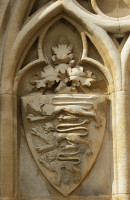
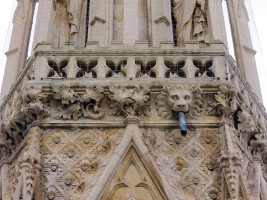
The first stage is hexagonal, an on each face is a blind Gothic window, of two lights, with sharply pointed gables above, and a central roundel in each case. Small shields are paired on each side, and are those of Castile and Leon and Ponthieu. As described by the Society of Antiquaries early in the 19th Century, ‘Over these compartments is a quatrefoil, and over that, in the point of the whole, a trefoil. The pediment of each compartment is richly frosted with leaves. The spandrels of each pediment are carved with eight-leaved flowers in lozenges, and the panels are parted by purled finials divided by two niches...’
Above is a balcony of pierced stone all the way round, with quatrefoils, crenellations, and facing downward, a series of carved blocks, with lion heads and foliage, mostly 19th Century restorative work, but the smaller bits, including little monstrous heads, likely being older, though whether they are original 13th Century I could not say.
The second stage is where the figural sculpture is. Hexagonal again, with three principal niches between beautiful columns, to give space for three statues of Queen Eleanor. They are not original, but replicas of the 1950s: the originals, recorded as being made by one Alexander of Abingdon, went first to Cheshunt Public Library, and thence to the V&A. Even those originals are not as they were: restoration by Sir Richard Westmacott took place in the 1830s, and again in the 1880s by Harry Hems, not at all so important a figure but a good enough architectural sculptor and decorator.
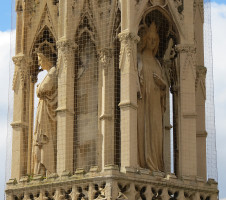 Positioning of the Eleanor statues on the second stage of Waltham Cross.
Positioning of the Eleanor statues on the second stage of Waltham Cross.
Looking at the 1950s statues, which can be presumed to be fair copies of the originals with all the caveats above, we see that the one stands slightly contrapuncto, one hand on her sceptre, which rests against her shoulder. Her other hand is clasping the loop of the necklace hanging on her chest – this hand above loop is also found in the Westminster Abbey effigy of Queen Eleanor by Torrigiano. She wears a crown, and has long hair – a feature of Eleanor statues, which eschew other head coverings, and a robe that falls straight and unornamented to cover her feet; over the top is a robe which forms pleasing if simple folds to left and right, and is draped over her upper arms.
The second statue of the Queen is similarly garbed and has her hands in similar but not identical position, but is posed with the weight on the other leg, her dress or shift is thinner, so we see the outline of her forward leg more clearly, and the outer robe has proper sleeves.
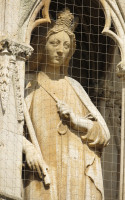 Face of Queen Eleanor (replica).
Face of Queen Eleanor (replica).
The third statue of Queen Eleanor is similar in pose again, but has heavier drapes with more complex folds, hanging across her front in a sort of apron, deeply undercut over the feet. She also has a sceptre, but her hand on her necklace is above a crucifix absent in the other two figures. This may be a feature of the various restorations and replacements rather than the original, as earlier accounts refer to ‘her left hand holding a cordon, and her right a sceptre or globe’. All three figures seem to lean forward a little, appropriate for their positions under the arches and above the viewer, but this one has the most dynamic pose of the three.
The top of this second stage rises to numerous crocketed spires all round, most pleasing to the eye, and within this frame is the third stage, much less in diameter, and perhaps two thirds the height. It echoes the first stage, with hexagonal sides bearing blind Gothic windows – single lights this time rather than doubled – and with crocketing and smaller spires above.
Finally, there is a stepped approach to the fourth stage, a thin ridged and crocketed spire, with a small cross on top – this is from the restoration in the 1830s, as older accounts refer to the broken shaft of a plain cross.
A panel on the railing notes the erection of the Cross by King Edward I in 1294, states it is the work of Roger de Crundale and [Nicholas] Dymenge de Leger, and that the original statues made by the sculptor Alexander de Abyndone (Alexander of Abingdon) are in Cheshunt Central Library – though as noted above, they have since found their way to the Victoria and Albert Museum. The railings themselves bear some decoration, notably the flowers at the top, rather nicely done.
Detail of railing, and 19th Century restoration of a lion head.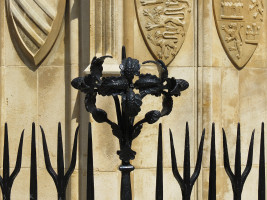
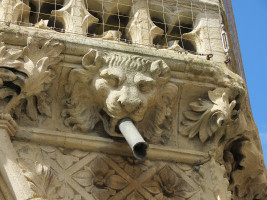
This page was originally part of a 'sculpture of the month' series, for Feb 2015. Although the older pages in that series have been absorbed within the site, if you would wish to follow the original monthly series, then jump to the next month (Mar 2015) or the previous month (Jan 2015). To continue, go to the bottom of each page where a paragraph like this one allows you to continue to follow the monthly links.
Eleanor Crosses // Hardingstone Eleanor Cross, Northampton
Visits to this page from 1 Feb 2015: 7,394